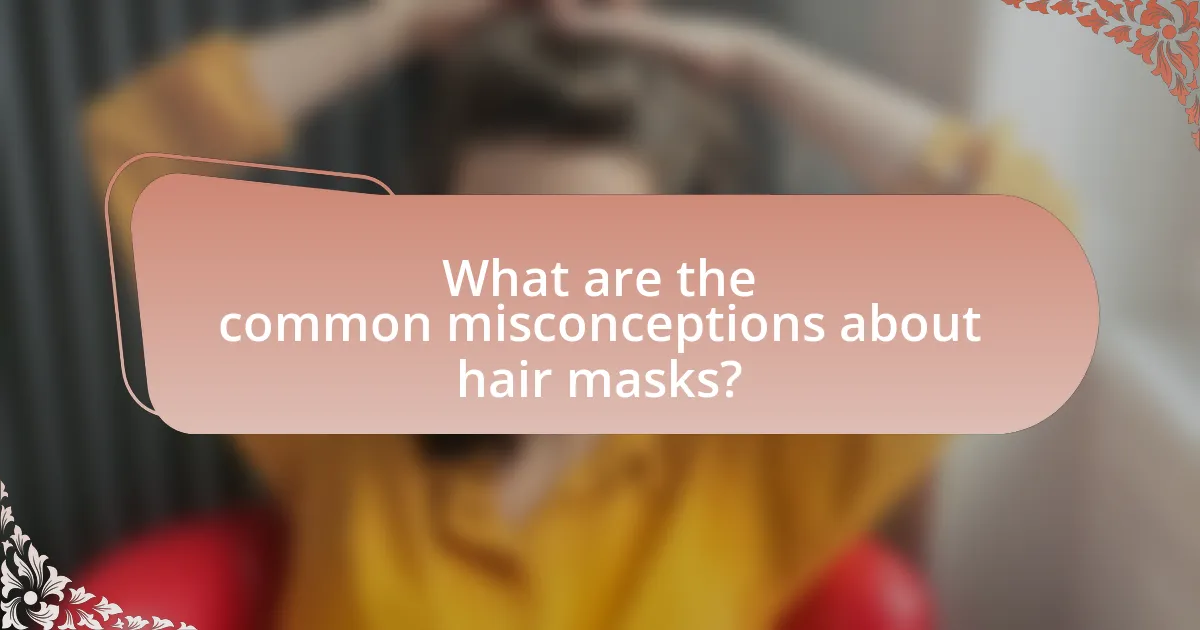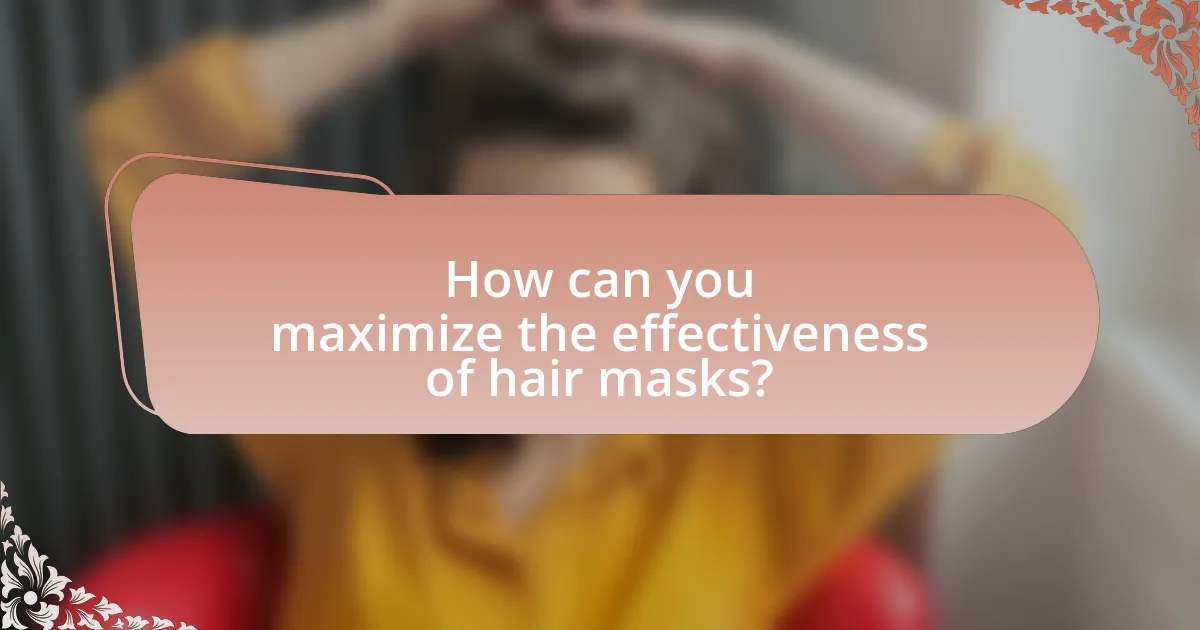The article focuses on the most effective hair masks for damaged hair, highlighting key ingredients such as keratin, argan oil, coconut oil, and shea butter that contribute to hair repair and nourishment. It discusses the benefits of hair masks, including deep conditioning, moisture restoration, and strength improvement, while also addressing how different masks target specific types of damage. The article reviews top-rated hair masks, their effectiveness based on user feedback, and provides guidance on selecting the right mask for individual hair types. Additionally, it covers common misconceptions, potential side effects, and best practices for maximizing the benefits of hair masks in hair care routines.

What are the Most Effective Hair Masks for Damaged Hair?
The most effective hair masks for damaged hair include those containing ingredients like keratin, argan oil, coconut oil, and shea butter. Keratin masks help to rebuild the hair structure, while argan oil provides essential fatty acids that nourish and hydrate. Coconut oil penetrates the hair shaft, reducing protein loss, and shea butter offers deep moisture and protection. Studies have shown that these ingredients significantly improve hair strength and reduce breakage, making them highly recommended for restoring damaged hair.
How do hair masks benefit damaged hair?
Hair masks benefit damaged hair by providing deep conditioning and nourishment that restores moisture, strength, and elasticity. These treatments often contain ingredients like oils, proteins, and vitamins that penetrate the hair shaft, repairing damage caused by heat, chemicals, and environmental factors. Research indicates that regular use of hair masks can significantly improve hair texture and reduce breakage, as they help to seal the cuticle and prevent further damage.
What ingredients should you look for in hair masks for damage repair?
Look for ingredients such as keratin, argan oil, shea butter, and hydrolyzed proteins in hair masks for damage repair. Keratin helps to rebuild the hair structure, while argan oil provides essential fatty acids that nourish and hydrate the hair. Shea butter acts as a natural emollient, sealing moisture and improving elasticity. Hydrolyzed proteins penetrate the hair shaft, strengthening and repairing damage. These ingredients are widely recognized in hair care for their effectiveness in restoring damaged hair, as supported by various studies highlighting their benefits in improving hair health and resilience.
How do different hair masks address specific types of damage?
Different hair masks target specific types of damage by utilizing unique ingredients that address particular hair concerns. For instance, protein-rich masks repair structural damage by reinforcing the hair shaft, making them effective for chemically treated or heat-damaged hair. Moisturizing masks, often containing oils and humectants, combat dryness and brittleness, providing hydration to parched strands. Masks with antioxidants, such as those containing vitamins A, C, and E, protect against environmental damage and promote overall hair health. Research indicates that using the appropriate mask can significantly improve hair strength and appearance, as evidenced by studies showing enhanced moisture retention and reduced breakage in treated hair.
What are the top-rated hair masks for damaged hair?
The top-rated hair masks for damaged hair include Olaplex No. 3 Hair Perfector, Briogeo Don’t Despair, Repair! Deep Conditioning Mask, and SheaMoisture Raw Shea Butter Restorative Hair Masque. These products are highly regarded for their ability to repair and nourish damaged hair. For instance, Olaplex No. 3 is known for its patented bond-building technology that strengthens hair from within, while Briogeo’s mask contains a blend of natural oils and vitamins that hydrate and restore shine. SheaMoisture’s formula is rich in shea butter, which deeply moisturizes and helps to restore elasticity. These masks have received positive reviews from users and beauty experts alike, confirming their effectiveness in treating damaged hair.
What makes each of these hair masks effective?
Each hair mask’s effectiveness is determined by its specific ingredients and their targeted benefits for damaged hair. For instance, masks containing proteins, such as keratin, help to rebuild and strengthen hair structure, while those with oils, like argan or coconut oil, provide deep hydration and nourishment. Additionally, masks enriched with vitamins, such as biotin and vitamin E, promote scalp health and enhance hair growth. The combination of these ingredients addresses various hair issues, such as dryness, breakage, and frizz, making the masks effective in restoring hair health.
How do user reviews and ratings reflect the effectiveness of these masks?
User reviews and ratings serve as a direct indicator of the effectiveness of hair masks for damaged hair. High ratings and positive reviews typically suggest that users have experienced noticeable improvements in hair health, such as increased moisture, reduced breakage, and enhanced shine. For instance, a hair mask with an average rating of 4.5 stars out of 5, accompanied by numerous testimonials highlighting significant hair repair, indicates strong user satisfaction and effectiveness. Conversely, low ratings and negative feedback often point to dissatisfaction, suggesting that the product may not deliver the promised results. Therefore, analyzing user reviews and ratings provides valuable insights into the real-world performance of these hair masks.
How can you choose the right hair mask for your hair type?
To choose the right hair mask for your hair type, first identify your specific hair needs, such as moisture, repair, or volume. For example, dry hair benefits from hydrating masks containing ingredients like argan oil or shea butter, while damaged hair requires protein-rich masks with keratin or amino acids to strengthen and repair. Research indicates that using a mask tailored to your hair’s unique characteristics can significantly improve its health and appearance, as evidenced by a study published in the Journal of Cosmetic Science, which found that targeted treatments yield better results than generic options.
What factors should you consider when selecting a hair mask?
When selecting a hair mask, consider the specific hair type and condition, as different formulations target various issues. For instance, a mask designed for dry hair typically contains hydrating ingredients like oils or butters, while a mask for damaged hair may include proteins to strengthen strands. Additionally, check for the presence of beneficial ingredients such as keratin, argan oil, or shea butter, which are known to improve hair health. The absence of harmful additives like sulfates and parabens is also crucial, as these can exacerbate damage. Finally, consider the application method and duration, as some masks require longer treatment times for optimal results.
How do hair types influence the choice of hair masks?
Hair types significantly influence the choice of hair masks due to their unique characteristics and needs. For instance, fine hair typically requires lightweight masks that provide moisture without weighing it down, while thick or curly hair benefits from richer, more hydrating formulas that can penetrate and nourish the strands effectively. Additionally, oily hair types may opt for masks that focus on balancing oil production and clarifying the scalp, whereas dry or damaged hair types often need masks rich in oils and proteins to restore moisture and strength. This tailored approach ensures that the specific needs of each hair type are met, leading to optimal results in hair health and appearance.

What are the common misconceptions about hair masks?
Common misconceptions about hair masks include the belief that they are only necessary for dry or damaged hair, that they can replace regular conditioner, and that they provide instant results. Hair masks benefit all hair types, not just those that are damaged, as they can help maintain moisture and health. Additionally, while hair masks can enhance the effects of regular conditioners, they should not be seen as a complete substitute; they serve different purposes in hair care routines. Lastly, users often expect immediate transformation, but consistent use over time is essential for noticeable improvements in hair health.
Why do some people believe hair masks are unnecessary?
Some people believe hair masks are unnecessary because they feel that regular conditioners provide sufficient moisture and nourishment for hair. This belief is supported by the idea that daily hair care routines, including shampooing and conditioning, can adequately maintain hair health without the need for additional treatments. Additionally, some individuals may perceive hair masks as time-consuming or an extra expense, leading them to prioritize simpler hair care methods.
What evidence supports the use of hair masks for hair health?
Evidence supports the use of hair masks for hair health through various studies demonstrating their benefits in improving hair moisture, strength, and overall appearance. For instance, a study published in the Journal of Cosmetic Dermatology found that hair masks containing natural oils, such as coconut oil and argan oil, significantly increased hair hydration and reduced protein loss, leading to healthier hair. Additionally, research from the International Journal of Trichology highlighted that regular use of hair masks can enhance hair elasticity and reduce breakage, particularly in chemically treated hair. These findings indicate that hair masks can be an effective treatment for maintaining and improving hair health.
How can misinformation affect hair care routines?
Misinformation can significantly disrupt hair care routines by leading individuals to adopt ineffective or harmful practices. For instance, false claims about the benefits of certain ingredients may result in the use of products that do not address specific hair issues, such as dryness or damage. Research indicates that many consumers rely on anecdotal evidence rather than scientific data, which can perpetuate myths about hair care, such as the belief that frequent washing is detrimental to hair health. This can lead to improper cleansing routines that exacerbate hair problems. Furthermore, misinformation can cause individuals to overlook effective treatments, such as specific hair masks designed for damaged hair, ultimately hindering their hair recovery process.
What are the potential side effects of using hair masks?
The potential side effects of using hair masks include allergic reactions, scalp irritation, and buildup of product residue. Allergic reactions can occur due to specific ingredients, such as fragrances or preservatives, leading to symptoms like itching or redness. Scalp irritation may arise from harsh chemicals or excessive use, causing discomfort or inflammation. Additionally, if hair masks are not thoroughly rinsed out, they can lead to product buildup, making hair feel greasy or weighed down. These side effects highlight the importance of selecting appropriate products and using them as directed.
How can allergic reactions occur with certain ingredients?
Allergic reactions can occur with certain ingredients when the immune system mistakenly identifies a harmless substance as a threat, triggering an immune response. This response can involve the release of histamines and other chemicals, leading to symptoms such as itching, swelling, or redness. Specific ingredients commonly associated with allergic reactions in hair masks include fragrances, preservatives, and certain botanical extracts, which can sensitize individuals over time. Studies indicate that approximately 1-3% of the population experiences contact dermatitis due to allergens in cosmetic products, highlighting the importance of ingredient awareness for consumers.
What precautions should you take when using hair masks?
When using hair masks, it is essential to conduct a patch test to avoid allergic reactions. This precaution involves applying a small amount of the product to a discreet area of the skin and waiting 24 hours to check for any adverse reactions. Additionally, it is important to follow the manufacturer’s instructions regarding application time and frequency to prevent product buildup or scalp irritation. Using hair masks on clean, damp hair can enhance absorption, while avoiding application on the scalp can prevent greasiness. Lastly, individuals should choose products that suit their specific hair type and needs to maximize effectiveness and minimize potential damage.

How can you maximize the effectiveness of hair masks?
To maximize the effectiveness of hair masks, apply them to clean, damp hair for optimal absorption. Research indicates that hair cuticles are more receptive to treatment when slightly wet, allowing the mask’s nourishing ingredients to penetrate more deeply. Additionally, using heat, such as a warm towel or a shower cap, can enhance the mask’s efficacy by opening the hair cuticles further, which has been shown to improve moisture retention and overall hair health.
What application techniques enhance the benefits of hair masks?
Applying hair masks effectively enhances their benefits through techniques such as sectioning hair, using heat, and ensuring proper distribution. Sectioning hair allows for even application, ensuring that all strands receive treatment. Applying heat, either through a warm towel or a heated cap, opens the hair cuticles, allowing deeper penetration of the mask’s ingredients. Additionally, using a wide-tooth comb after application helps distribute the product evenly, maximizing its effectiveness. These techniques are supported by studies indicating that heat can increase the absorption of conditioning agents in hair treatments.
How long should you leave a hair mask on for optimal results?
For optimal results, you should leave a hair mask on for 20 to 30 minutes. This duration allows the ingredients to penetrate the hair shaft effectively, providing deep conditioning and nourishment. Research indicates that leaving a hair mask on for this time frame maximizes the benefits of the active ingredients, enhancing moisture retention and improving hair texture.
What additional treatments can complement hair masks?
Additional treatments that can complement hair masks include deep conditioning treatments, scalp massages, and hair oils. Deep conditioning treatments provide intense moisture and repair, enhancing the effects of hair masks. Scalp massages stimulate blood circulation, promoting healthier hair growth and allowing better absorption of nutrients from hair masks. Hair oils, such as argan or coconut oil, can seal in moisture and add shine, further improving hair texture and health when used in conjunction with masks. These complementary treatments work synergistically to maximize the benefits of hair masks, leading to improved hair condition and appearance.
What are some tips for incorporating hair masks into your routine?
To effectively incorporate hair masks into your routine, apply them consistently, ideally once a week, to achieve optimal results. Regular use allows the hair to absorb nutrients and moisture, promoting healthier strands. Additionally, choose a hair mask that targets your specific hair concerns, such as dryness or damage, to maximize benefits. For best results, apply the mask to clean, damp hair and leave it on for the recommended time, usually between 10 to 30 minutes, to ensure deep penetration of ingredients. Finally, consider using a shower cap to enhance the mask’s effectiveness by trapping heat, which can help open the hair cuticles for better absorption.
How often should you use hair masks for best results?
For best results, hair masks should be used once a week. This frequency allows for optimal hydration and nourishment without overloading the hair, which can lead to buildup or greasiness. Research indicates that weekly application can significantly improve hair texture and moisture levels, as the hair benefits from the concentrated ingredients in the mask. Regular use helps maintain hair health, especially for damaged or dry hair types.
What are the best practices for storing and using hair masks?
The best practices for storing and using hair masks include keeping them in a cool, dry place, ideally in a sealed container to prevent contamination and degradation. Hair masks should be used according to the manufacturer’s instructions, typically applied to clean, damp hair and left on for a specified duration to maximize absorption of nutrients. For optimal results, it is recommended to use hair masks once a week, as frequent use can lead to buildup or weigh down the hair. Proper storage and usage ensure the effectiveness of the ingredients, such as oils and proteins, which can degrade if exposed to heat or light.


